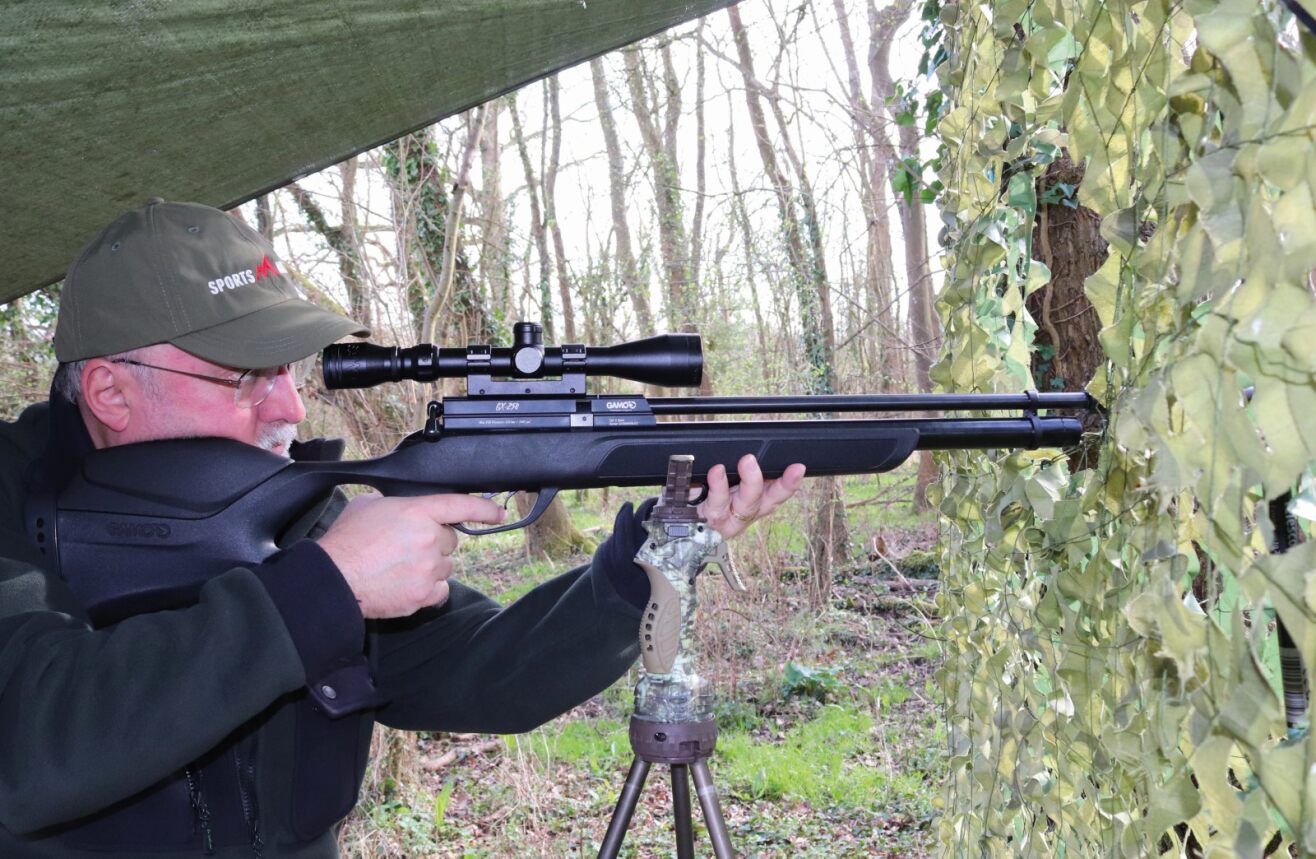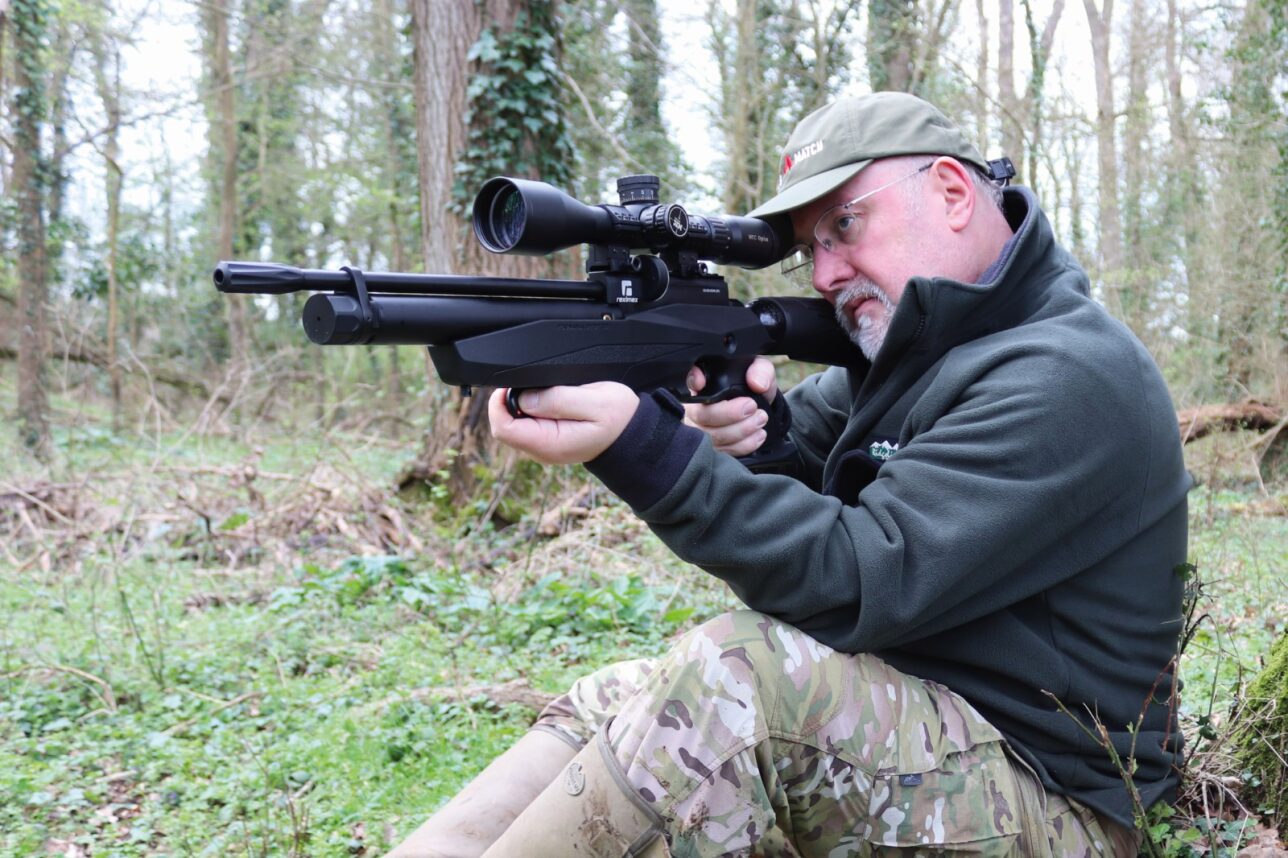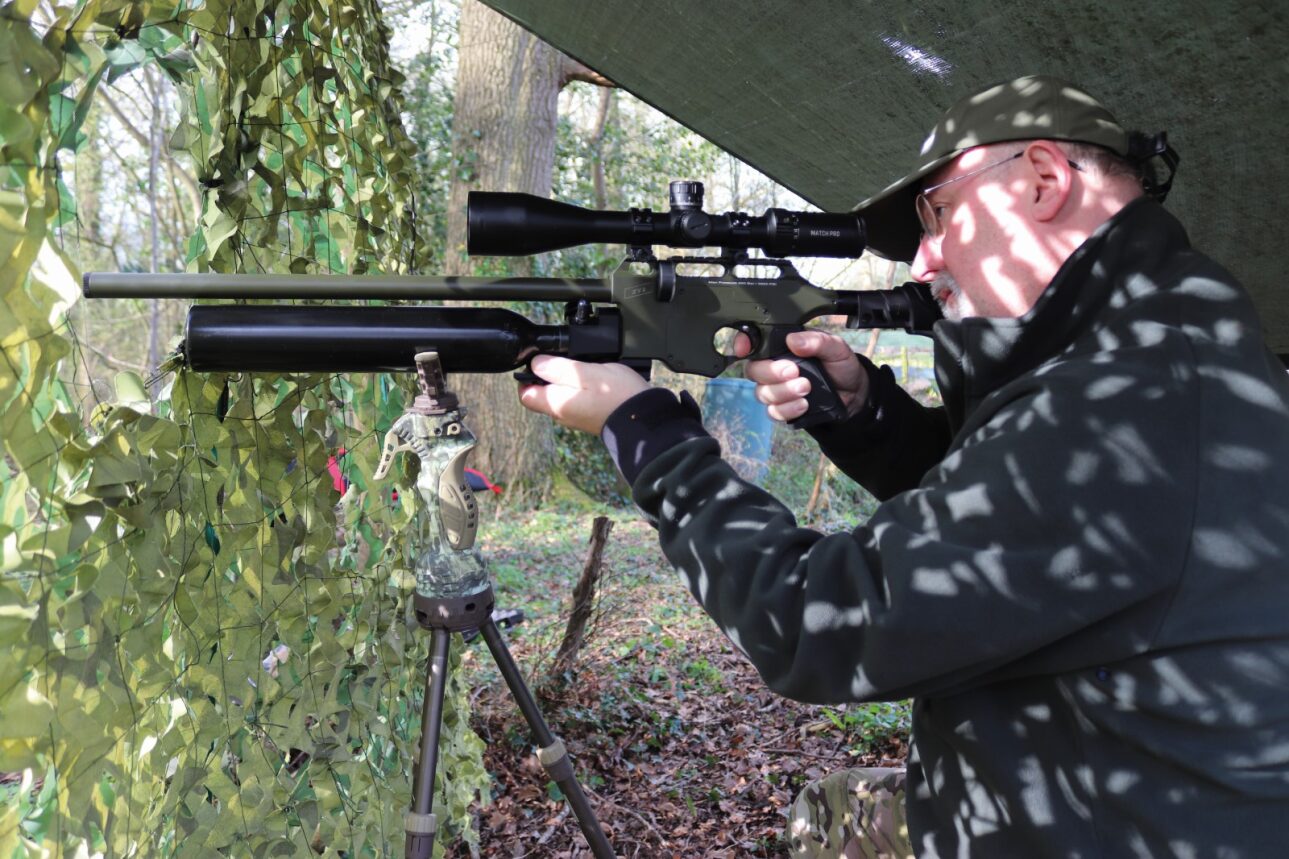Right now is the best time to be an airgunner – modern PCP rifles would send our grandfathers, into a tailspin. Not so long ago you could have any air rifle you liked as long as it had a spring in it, and that suited us just fine, but then pre-charged pneumatic rifles came along and everything changed. Ever since, airgun manufacturers have been engaged in an arms race that has seen the bar pushed higher and higher in terms of sophistication, features and price.
Of course, we as consumers are the beneficiaries – as long as you have the money to spare. There’s no denying that the top brands produce the top rifles that are a joy to handle and shoot, and walnut stocks, regulated actions and fancy features are all well and good, but do you need a top-of-the-range rifle to put rabbits on the table? To find out, we’ve assembled four PCP rifles that have a price tag of £550 or less, to see if they are good enough for hunting.
Gamo GX-250
£399
gamoguns.co.uk

The affordable PCP market is booming, but despite an influx of new rifles and manufacturers, Gamo has more than held its own because its PCPs offer a superb blend of quality, affordability and performance.
The GX-250 is a case in point, not least because shopping around will bring the already low RRP down even further, but because the GX-250 comes with a silencer and a 3-9 x 40 scope with mounts and a BSA-derived, cold-hammer forged barrel.
The black polymer stock is finished to a high standard with a barely perceptible moulding seam. It’s solid, too. In fact, at 3.8 kgs and 1,125mm including the scope and silencer, the GX-250 certainly counts as a full-size rifle and has a 370mm pull length.
A ventilated butt pad makes the rifle comfortable to shoulder and although the cheek comb looks like it adjusts, thanks to some sneaky moulding, it doesn’t – but it’s plenty high enough to ensure good eye alignment to the scope.
A large cut-out accesses an almost vertical pistol grip that has no embellishment save for panels of stippling either side. Above it, the bolt operates positively if a little stiffly to cock the action and cycle a pellet through the magazine, which accepts 10 shots in both .22 and .177 calibres.
Filling it is simply a case of dropping pellets into the chambers as you rotate the drum – no pre-rotation needed, and once full, the magazine pushes into the breech from the left. A window on the top indicates how many shots you have left.
Like so many affordable rifles, the trigger on the GX-250 is plastic, as is the safety catch blade just forward of it. That said, there’s no sense of flex or flimsiness, and although there is a little creep, the two stages are clearly defined and the let-off is predictable.
The air cylinder is filled to a maximum of 232 bar by fitting a probe into the port accessed by pulling off a collar on the front by the pressure gauge. Gamo quotes shot figures of 120 in .177, and 135 in .22.
I spent a few hours on the range with the .22 test rifle, and it became obvious within a magazine or two that the GX-250 was more than capable of taking on airgun quarry. The chrono’ showed an average power output of 11.1 ft.lbs. with 14.66 grain BSA Goldstar pellets and variation of 5fps over 10 shots. For its field test, I took the rifle on a squirrel shooting trip. From a hide and resting on trigger sticks, the long fore end made the GX-250 very comfortable to shoot, and together we accounted for four squirrels at a range of 27 yards – each one killed cleanly with a single shot.
Reximex Myth
£399
range-right.co.uk
 Available in either a black synthetic or walnut stock (£430), both of which come fitted with sling swivels, the Myth has an air cylinder at the front and buddy bottle at the back that combine to provide 380cc capacity. Although it may look like a take-down, it’s not, so don’t be tempted to unscrew the rear bottle. No doubt because of the set-up, the length of pull is a relatively short 330mm, although slackening off a couple of screws in the butt pad, which is also height adjustable, adds another 20mm. The pistol grip swells to fill your palm and the addition of finger contours makes it very comfortable to hold. Covered in stippling, it won’t slip in your hand either.
Available in either a black synthetic or walnut stock (£430), both of which come fitted with sling swivels, the Myth has an air cylinder at the front and buddy bottle at the back that combine to provide 380cc capacity. Although it may look like a take-down, it’s not, so don’t be tempted to unscrew the rear bottle. No doubt because of the set-up, the length of pull is a relatively short 330mm, although slackening off a couple of screws in the butt pad, which is also height adjustable, adds another 20mm. The pistol grip swells to fill your palm and the addition of finger contours makes it very comfortable to hold. Covered in stippling, it won’t slip in your hand either.
Out of the box, the metal post and shoe trigger had a little sideways movement on the first stage. However, the stop before the second stage was very obvious and the let-off nice and clean. Pushing the cross-bolt safety button through to the left makes the rifle live, and hunters will be pleased to know that with a little care, it’s almost silent to operate.
Mounted on the right with no capacity to swap it over, the sidelever is sprung for the first stage, and with the cocking stroke complete, locks firmly back into position. The process seats a pellet from the 14-shot .177 or 12-shot .22 magazine into the breech.
To load the magazine, a clear plastic face plate must first be rotated clockwise. Dropping the first pellet in holds the spring in place, so you can turn the faceplate back again, dropping pellets into the chambers as they are exposed. Inserting the magazine from the right requires a ridge on the back to be aligned with a groove at the top of the breech. In addition to a single-shot tray, you get two magazines, the spare being held in a recess forward of the trigger.
The 65mm scope rail is split by the magazine and designed to take either 11mm dovetail or 22mm Picatinny mounts. Below it on the right is a power adjustment dial, which works by choking off the transfer port, but won’t lead to more shots.
Pulling a cap off the front of the air cylinder accesses the fill valve. A 250 bar maximum is indicated but distributors Range Right recommend a 200-bar fill and say you can expect around 150 shots.
The 380mm barrel is not shrouded, but finished with a fluted muzzle protector. Hunters will want to fit a silencer – achieved by removing the protector to reveal a ½” UNF thread – the Myth has quite a bark. I’ve hunted with the Myth before, so my preparation was simply limited to zeroing in the scope with JSB Exact pellets and satisfying myself that the rifle was accurate enough to take on live quarry. It was, proved by the three or woodpigeons I was able to dispatch.
JTS Airacuda Max
£549
shootingparty.uk

At 1,040mm and 3.75 kgs, the JTS Airacuda Max has a feel of quality and solid engineering that is sometimes lacking even on more expensive rifles. The ambidextrous beech stock is beautifully proportioned and finished to a very high standard, as is the metal work. There’s no adjustment to the solid rubber shoulder pad, but slackening off a screw in the lower part of the butt allows the cheekpiece to be raised, and if your scope has an extra-large objective lens, more adjustment is available via a screw in the top part of the butt.
A large cut-out accesses the pistol grip that swells nicely to fit the palm and has panels of chequering on each side. Length of pull is 360mm and the trigger curves comfortably to the finger. The two stages can be adjusted using screws accessed via slots in the trigger guard, which also houses a large safety switch. The first stage is smooth and comes to a distinct stop before breaking cleanly.
The quality of the trigger is matched by the sidelever located on the right of the rifle and cannot be swapped. The large drop-down handle operates the sprung first stage. Pulling back the second stage is buttery smooth and lock up on return ensures that the whole cocking process adds to the pleasure of shooting the Airacuda Max.
You get a single-shot tray and two metal magazines, which feel like they should be part of a more expensive rifle. They require no pre-rotation – simply drop a pellet into the hole nose first and turn the inner drum anti-clockwise to reveal new chambers. The .22 rifle takes 10-shots and the .177 takes 12. Loading into the breech is simply a case of pulling back the side lever and inserting the magazine from the left. The only quibble is that the probe will drop toward the breech under gravity.
A regulator combined with a large air cylinder ensures plenty of shots – up to 220 in .22 and 150 in .177 are claimed. Filling the Airacuda Max to the recommended 200 bar is achieved by unscrewing a cap at the end of the cylinder. The valve is designed to attach straight to a Foster fit connector, so no probe to lose. Pressure gauges located under the fore end, where you’ll also find a Picatinny accessory rail, indicate overall fill pressure as well as regulator pressure.
The full-length shroud measures 610mm and is finished with a ½” UNF thread to accept a silencer. Owners of some early JTS Airacuda Max rifles found that pellets clipped the silencer. The issue has now been addressed and The Shooting Party has developed a silencer in partnership with JTS. More than that, the company says it will provide a silencer free of charge, including postage, to anyone still having clipping problems. All that’s needed is an email with the rifle’s serial number.
Time on the range revealed 11.78 ft.lbs. and one-hole groups at 30 metres with .22 calibre JSB Hades pellets. Variation of a 10-shot string was just 6fps. As a result, the following day saw me sitting in the woods hoping for a rabbit to emerge. One did eventually, and at 28 metres, the JTS Airacuda Max took care of business with a minimum of fuss.
Edgar Brothers EV2
£499
edgarbrothers.com

The EV2 we have on test is priced the same as the wooden-stocked Agincourt and a little under £100 less than the top of the range and regulated EV2 RS. Supplied with a plastic hard case and available in bronze, black, Flat Dark Earth or olive green, the EV2 measures 940mm and weighs 3.4 kgs unscoped and without a silencer.
There’s no height adjustment on the shoulder pad, but pushing a button on the underside of the butt, which has holes to accept a sling swivel, extends the length of pull in five lockable positions between 325 and 405mm. The cheekpiece also adjusts via a thumbscrew with eight heights indicated.
The slim rubberised pistol grip has a couple of finger contours and patches of moulded stippling, to make it comfortable and reduce the potential for it to slip in your hand.
Above it, the sidelever has a drop-down handle and operates in two stages – the first one sprung. The second stage has a short throw and operates smoothly with purposeful simplicity to cycle pellets through the 12-shot .22 or 14-shot .177 plastic magazine, of which there are two.
The curved metal trigger fits the finger nicely, and although not adjustable, the weight on the short first and longer second stage were set up perfectly for me. Located within the trigger blade, the safety button is easy to access and locks everything up when pushed through to the right.
A Picatinny rail provides plenty of room for a scope. Having to accommodate the magazine means it’s split into two and there’s just one position on the forward section to lock onto. However, I had no problems mounting a scope and the telescopic butt section should allow just about any size optic.
Up front, there’s a huge 500cc aluminium bottle, filled via a valve located by the neck and protected by a plastic cap that I found a little difficult to pry loose at first. Although the valve looks like it will take a standard Foster fit connection, it won’t, and you’ll need to use the connector provided.
The EV2 has a recommended maximum fill pressure of 250 bar. Being unregulated, the rifle has a sweet spot, which I found to be between roughly 90 and 160 bar that was good enough for 150 shots.
A full-length shroud that incorporates a stack of baffles on top of the 380mm barrel makes the EV2 acceptably quiet to hunt with, which is handy because there’s no capacity to fit a silencer to the shroud. If having one is important to you the shroud can be unscrewed and a silencer fitted to a ½” UNF thread on the barrel itself.
On the range, the EV2 produced a respectable 11.24 ft.lbs. with a variance of 13fps over a 10-shot string at 140 bar. Accuracy was good too, with ragged one-hole groups at 20 and 30 metres using .22 JSB Hades pellets.
As a result, the EV2 accompanied the Gamo GX-250 on my squirrel control session where it performed admirably, despatching five of the pests with clean single-shot kills at 27 metres, resting on a set of trigger sticks.
SUMMARY
How much you need to spend on a rifle is shaping up to rival the .177 versus .22 debate. The reality is that affordable rifles have the potential to be just as accurate for hunting as rifles that cost much more. Some will argue that premium brands are better engineered, more tactile to handle and make the shooting experience more pleasurable. I’m sure there’s a lot to be said for such an argument, but during my many hunting trips with the rifles in our line-up, at no point did I feel that I was at a disadvantage. With just 12 ft.lbs. for most of us to play with, fieldcraft and the ability to get close enough to make a telling shot is at the heart of air rifle shooting, no matter how expensive your equipment – and you can’t put a price on that.